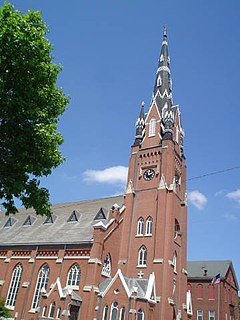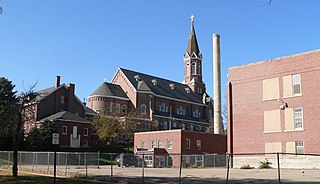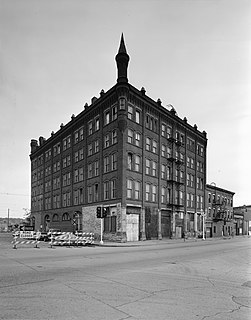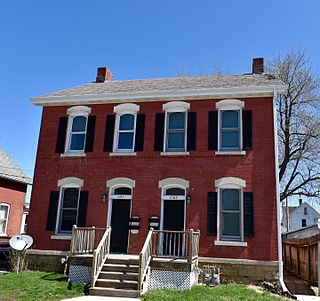
Saint Mary's Catholic Church is a former parish of the Archdiocese of Dubuque. The church is located in Dubuque, Iowa, United States, at the corner of 15th and White Streets. The church is recognizable by its steeple– one of the tallest in the area. The church property was added to the National Register of Historic Places as an historic district in 2015, and the various buildings were included as contributing properties in the Washington Residential Historic District later in the same year.

Saint Patrick's Church is a Catholic parish in the Archdiocese of Dubuque, and is located at 15th and Iowa Streets, Dubuque, Iowa, United States. The church and rectory were included as contributing properties in the Jackson Park Historic District that was listed on the National Register of Historic Places in 1986. St. Patrick's Church is located two blocks away from St. Mary's Church. The reason for the close proximity of the two parishes was that St. Mary was originally built for service to German families of Dubuque, and St. Patrick's provided services for the Irish settlers to Dubuque.

The Park House Hotel, also known as St. Agatha's Seminary and Burkeley Apartments, is an historic building located in Iowa City, Iowa, United States. The building was built in 1852 for Ferdinand Haberstroh. It catered to those who did business when the city was the capitol of Iowa, and it is one of the few remaining commercial buildings from that era. After Haberstroh died in 1860, the Rev. William Emonds of near-by St. Mary's Catholic Church bought the property and its debt. Two years later the Sisters of Charity of the Blessed Virgin Mary from Dubuque, Iowa opened St. Agatha's Female Seminary. The building acquired its mansard roof in 1875. Classrooms were located on the first two floors and residential space for the sisters and students who boarded here were on the upper two floors. The school closed in 1909 and Albert Burkeley converted the building into a women's boarding house called "Svendi". After 1918 it became an apartment building known as "Burkeley Place", and it has been an apartment building ever since.

Cathedral Historic District is a nationally recognized historic district located in Dubuque, Iowa, United States. It was listed on the National Register of Historic Places in 1985. At the time of its nomination it consisted of 124 resources, which included 96 contributing buildings, one contributing site, one contributing structure and 26 non-contributing buildings. The district was the first residential area in Dubuque, and developed into a tightly-knit neighborhood. It is located west of the original commercial district and below the bluffs of the Mississippi River that rise steeply to the west. Although its original structures no longer stand, its historic buildings are largely from the mid to late 19th century. St. Raphael's Cathedral complex, from which the district receives its name, was important in serving immigrants, including most of the Irish immigrants to the city, and in building ties. In 1985, the district was deemed to have retained "most of its original character and fabric" from the late 1800s. Washington Park, J.H. Thedinga House (1855), Fenelon Place Elevator, and Redstone (1888) are all individually listed on the National Register.

St. Patrick's Catholic Church is a parish of the Archdiocese of Dubuque. The church is located in northwest Jackson County, Iowa, United States in an unincorporated community in Butler Township called Garryowen. It was listed on the National Register of Historic Places in 1992.

St. Boniface Catholic Church is a parish of the Diocese of Sioux City. The church is located in a residential area west of downtown Sioux City, Iowa, United States. The parish buildings form a nationally recognized historic district that was listed on the National Register of Historic Places in 1998 as St. Boniface Historic District. At the time of its nomination it contained three resources, all of them contributing buildings.

Lancaster City Historic District is a national historic district located at Lancaster and Manheim Township, Lancaster County, Pennsylvania. It measures 3 square miles and includes 13,459 contributing buildings, 9 contributing sites, 6 contributing structures, and 19 contributing objects in the city of Lancaster. The buildings date from 1760 to 1950, with the majority dating from 1860 to 1930. A number of buildings were designed by Lancaster architect C. Emlen Urban. All the previously listed individual buildings and structures and historic districts are included in this district. Other notable buildings and sites include the City Hall (1891-1892), Lancaster County Prison (1851), Miller and Hartman Building, Shaub Shoe Store, Watt & Shand, Conestoga Steam Cotton Works (1845-1910), Posey Iron Works, St. Mary's Catholic Church, Temple Shaarai Shamoyim (1895-1896), Bethel A.M.E. Church, the Unitarian Universalist Church of Lancaster, Pennsylvania Railroad Station (1929), Lancaster Cemetery, Woodward Hill Cemetery, and Zion Lutheran Cemetery.

The Bishop's Block, also known as the Bishop's Block Apartments, is an historic building located in Dubuque, Iowa, United States. It was individually listed on the National Register of Historic Places in 1994. It was included as a contributing property in the Old Main Street Historic District in 2015.

Oil City South Side Historic District, also known as Venango City and Laytonia, is a national historic district located at Oil City, Venango County, Pennsylvania. It is directly south of the Oil City Downtown Commercial Historic District. The district includes 882 contributing buildings and 2 contributing objects in a mixed use section of Oil City. It includes a large number of dwellings, commercial buildings, churches, and institutional buildings. The houses were built between about 1863 and 1945 and are in a variety of popular architectural styles including Romanesque Revival, Late Gothic Revival, Second Empire, Colonial Revival, Classical Revival, Bungalow, American Foursquare, and Italianate. Notable non-residential buildings include the Carnegie Library (1905), Latonai Theater (1928), Knights of Columbus Hall (1927-1928), Good Hope Lutheran Church Rectory (1928), Christ Episcopal Church (1886), St. Stephen's Roman Catholic Church (1906), and Second Lutheran Church (1913). Located in the district is the separately listed Oil City Armory.

Butler Historic District is a national historic district located at Butler, Butler County, Pennsylvania. The district includes 128 contributing buildings, 1 contributing site, and 4 contributing objects in the central business district of Butler. It includes primarily commercial and institutional buildings, with some residential buildings, built between about 1828 and 1952 in a number of popular architectural styles including Late Victorian. Notable buildings include the City Hall, former U.S. Post Office (1912), Koch Building, T.W. Phillips Co. Office Building, Masonic Temple (1910), Butler High School (1917), Butler YMCA (1895), Butler YMCA (1913), First Evangelical Lutheran Church (1897), St. Andrews United Presbyterian Church, John Quincy Adams Kennedy House, St. Mark's Evangelical Lutheran Church and School, First Baptist Church (1914), St. Paul's Roman Catholic Church (1909), and Butler Savings and Trust (1925). The contributing site is the Diamond, that contains the contributing objects including the Soldiers and Sailors Monument (1894). Located in the district and listed separately are the Butler County National Bank, the Sen. Walter Lowrie House, and the Butler County Courthouse.

The St. Joseph's Church Complex is a collection of historic buildings located in Fort Madison, Iowa, United States. At one time the complex housed a Catholic parish in the Diocese of Davenport. St. Joseph and St. Mary of the Assumption parishes merged in the 1990s to form Saints Mary and Joseph Parish. In 2007 when that parish merged with Sacred Heart on the west side to form Holy Family Parish, St. Joseph's Church was closed. The former church, chapel, rectory, convent, and school were included as contributing properties in the Park-to-Park Residential Historic District that was listed on the National Register of Historic Places in 2014.

The Park-to-Park Residential Historic District in Fort Madison, Iowa, United States, was listed on the National Register of Historic Places in 2014. The historic district is located to the north of the Downtown Commercial Historic District, generally between Central Park on the west and Old Settler's Park on the east. Both parks are contributing sites. For the most part the district is made up of single family homes built in the late 19th and early 20th centuries. Some of these homes were built as rental properties, while others became so in later years. The Albright House and the Chief Justice Joseph M. Beck House are contributing properties, and they are also individually listed on the National Register. There are also duplexes and a few small scale apartment buildings in the district.

The Hollenfelz House, also known as St. Mary's High School for Boys, is a historic building located in Dubuque, Iowa, United States. This highly decorative Second Empire structure was built as a home for Michael Hollenfelz, who owned a wholesale firm dealing with wines, liquors and beer. The building features a mansard roof with dormers and a cupola, which is normal for this style, and High Victorian decorative details, which is not. Particularly unusual is the cornice and the stringcourses. In 1906 it was acquired by St. Mary's Catholic Church across the street for a boy's high school. The school was operated by the Brothers of Mary from St. Louis, and its curriculum focused on business and commerce. That school ceased operations in 1929 and the building was then used for the parish grade school. In 1957 it was converted into an apartment building. It was individually listed on the National Register of Historic Places in 1977, and it was included as a contributing property in the Washington Residential Historic District in 2015.

The Dubuque Casket Company is a historic building located in Dubuque, Iowa, United States. The city was a leading national market in the production of caskets towards the end of the 19th century. This location had been the site of a casket manufacturing plant from 1877 to 1987. The Dubuque Furniture and Burial Case Company was the first firm in Dubuque and the first to locate here. The building was largely destroyed by fire in 1883 and the company was forced out of business. The Dubuque Casket Company was incorporated in 1893 and acquired this property. They started construction of the first part of this building the same year. The four-story brick Neoclassical building was one of the largest manufacturing facilities in Dubuque. The machine and equipment room was located on the first floor, they manufactured fine cloth covered caskets on the second floor, they manufactured undertaker's dry goods on the third floor, and the fourth floor was used for storage. The first addition, now known as the center section was begun in 1903, and another expansion that also unified the main facade was begun in 1911. Two other Dubuque casket manufacturers, Iowa Coffin Company and the Hawkeye Casket Company, were out of business by 1924.

Jackson Park Historic District is a nationally recognized historic district located in Dubuque, Iowa, United States. It was listed on the National Register of Historic Places in 1986. This is primarily a residential area, with some institutional and commercial buildings, located north of the central business district. The city originally developed just to the south of here. The Cathedral Historic District represents the oldest residential neighborhood in Dubuque, and began to house the working-class people closer to the docks. Once the Jackson Park area opened for development the city's wealthier residents built their homes here. Architectural styles rang from the vernacular, which are found mainly along the bluff, to the high style found mainly along Main and Locust Streets. Most of the houses were built from the mid to the late 19th century. The Andrew-Ryan House (1873) was individually listed on the National Register. Most of the institutional architecture are churches, which include St. John's Episcopal Church (1878) and St. Patrick's Catholic Church (1878). Central High School, no longer extant, was located across from Jackson Park, and it was also individually listed on the National Register before its demise. The Carnegie-Stout Public Library (1902) is located on the south side of the district.

Langworthy Historic District is a nationally recognized historic district located in Dubuque, Iowa, United States. It was listed on the National Register of Historic Places in 2004. At the time of its nomination it consisted of 110 resources, which included 94 contributing buildings, five contributing structures, nine non-contributing buildings, and two non-contributing structures. This residential area was developed from the end of the American Civil War to the beginning of World War I. Most of the houses were built between 1890 and 1910, with four large houses pre-dating the Civil War. For the most part, the houses here are larger in scale and include examples of Victorian and the various revival and American Movement styles from the late 19th and 20th centuries. The district is completely residential with no commercial or institutional buildings, and with only one multi-family house, a duplex. Two houses were individually listed on the National Register: Langworthy House, an Octagon house from 1855, and the Garland House (1907). The district derives its name from the Langworthy family who were early settlers in Dubuque and played a prominent role in the development of the local lead mining industry and the city itself. Three of the brothers built houses here.

West Eleventh Street Historic District is a nationally recognized historic district located in Dubuque, Iowa, United States. It was listed on the National Register of Historic Places in 2004. At the time of its nomination it consisted of 288 resources, which included 191 contributing buildings, 32 contributing structures, 61 non-contributing buildings, two contributing sites, and one non-contributing structure. This district is a residential area on top of the bluff above the Jackson Park Historic District, which is in the river valley below. Its name comes from its historical association with the former West Eleventh Street Elevator, a funicular that was similar to the Fenelon Place Elevator to the south. For the most part the historic buildings here are single-family residences with their attendant out-buildings, although the number of out-buildings located here is relatively low. There is one apartment building and 46 duplexes. Some of the single-family houses were converted into multi-family residences, and then some of those were converted back. The various Victorian styles are found along the bluff fronts on the eastern and southern edge of the district, and vernacular structures on the northern and western sections. The Charles T. Hancock House (1890) was individually listed on the National Register. Given the steep bluffs in the district the historic structures are retaining walls and steps that replace the sidewalks.

Washington Street and East 22nd Street Historic District is a nationally recognized historic district located in Dubuque, Iowa, United States. It was listed on the National Register of Historic Places in 2015. At the time of its nomination it consisted of 34 resources, which included 29 contributing buildings, and five non-contributing buildings. The focus of this district is a cluster of brick buildings around the intersection of Washington and East 22nd Streets on the north side of Dubuque. Its location west of the former Chicago Great Western Railway and the Chicago, Milwaukee, St. Paul and Pacific Railroad yards led to a large percentage of the residents here to be higher ranking railroad employees. The historic buildings are brick and frame houses, with the exception of one brick storefront/residence. Most of the houses are front or side gabled vernacular structures, and a few that are Italianate or Classical Revival. Couler Creek, which was located behind the houses on the east side of Washington Street, also affected the development of this area. There is no alley behind the houses on the east side of Washington. Flooding was also a major problem in this area until the creek was covered in a stone-arched sewer and continues to flow under ground.

The Seminary Hill Residential Historic District is a nationally recognized historic district located in Dubuque, Iowa, United States. It was listed on the National Register of Historic Places in 2015. At the time of its nomination it consisted of 55 resources, which included 38 contributing buildings, one contributing site, one contributing object, 13 non-contributing buildings, one non-contributing structure, and one non-contributing object. The district is a blufftop residential area that surrounds Madison Park. It takes its name from its proximity to the former German Theological Seminary, now the seminary located at the University of Dubuque. Clarke Drive, the main artery through the district, was also known as Seminary Street at one time. About half of the historic buildings here are brick. The Italianate style is dominate, with several examples of the Italian Villa design. There are also a few examples of the Second Empire, Queen Anne, and Classical Revival styles. This residential area was developed between 1855 and 1919.

The Jefferson Street Historic District is a nationally recognized historic district located in Iowa City, Iowa, United States. It was listed on the National Register of Historic Places in 2004. At the time of its nomination it consisted of 39 resources, which included 36 contributing buildings and three non-contributing buildings. This section of the city started to develop to its present form in the late 19th and early 20th centuries. During this period the neighborhood was transformed from residential to include churches and buildings associated with the University of Iowa and its hospitals. Both professionals and business owners lived here, along with working-class people. Graduate students, especially those associated with the medical professions, resided in apartment buildings here. Four architecturally significant churches, along with their attendant buildings, are located in the district.























